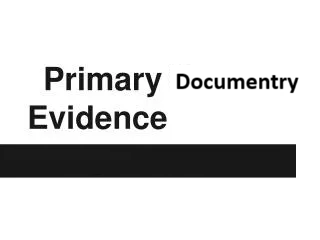The concept of primary evidence is addressed under Section 57 of the Bharatiya Sakshya Adhiniyam, 2023. It embodies the best evidence rule, which insists that the best available evidence be brought before the court.
Definition of Primary Documentary Evidence:
Under Section 57 of the Bharatiya Sakshya Adhiniyam, 2023, Primary Evidence refers to the original document itself produced before the court for inspection.
Key Features of Primary Documentary Evidence:
- Original Document:
- It is the best form of evidence.
- Must be produced in its original form unless otherwise provided under the law.
- Direct Production:
- The document must be directly presented to the court by the party relying on it.
- No Need for Explanation:
- Unlike secondary evidence, primary evidence does not require justification for its admissibility.
- Multiple Originals:
- If a document has been executed in several parts (e.g., contracts signed in duplicate), each part is primary evidence.
Examples of Primary Evidence:
| Document Type | Primary Evidence Form |
| A written contract | The original signed contract |
| A will | The original signed and attested will |
| A sale deed | The registered sale deed document |
| Handwritten letter | The original letter written and signed by the author |
| Electronic record | The original file or authentic digital source (as per S.63)* |
* Note: The treatment of electronic records is governed with special provisions under digital evidence laws. But the principle of “best evidence” still applies.
Legal Significance:
- Direct Proof: It helps the court ascertain the content of the document without inference.
- Authenticity Presumed: Courts give higher probative value to original documents.
- Foundation for Claims: In civil suits (especially in contract or property matters), the entire case may rest on primary documents.
Relevant Provision (Verbatim):
“Primary evidence means the document itself produced for the inspection of the Court.”
– Section 57(1), Bharatiya Sakshya Adhiniyam, 2023
Difference from Secondary Evidence:
| Aspect | Primary Evidence | Secondary Evidence |
| Form | Original document | Copy or substitute of the original |
| Admissibility | Admissible without conditions | Admissible only under specific grounds |
| Legal Weight | Highest | Lower than primary evidence |
What is Primary Documentary Evidence?
Primary documentary evidence refers to the original document itself, produced for the inspection of the court. It is considered the best evidence available to prove the contents of a document.
Legal Basis under Bharatiya Sakshya Adhiniyam:
Section 62 of the old Indian Evidence Act corresponds to Section 57 of the Bharatiya Sakshya Adhiniyam, 2023.
Section 57 – Primary Evidence (under Bharatiya Sakshya Adhiniyam, 2023):
➤ It defines primary evidence as the document itself produced for the inspection of the court.
➤ Where a document is executed in multiple parts (like contracts signed in duplicates or triplicates), each part is considered primary evidence.
➤ If a document is made by mechanical processes (like printing, lithography, photography), each counterpart intended to have the same effect is primary evidence.
➤ When documents are made by uniform processes (e.g., carbon copies), and one is the original, only the one intended as the original is primary evidence. The rest may be considered secondary unless otherwise proven.
Examples of Primary Documentary Evidence:
- The original signed contract between two parties.
- The original sale deed or title deed in property matters.
- A photograph negative (in case of photographs, the negative is primary evidence).
- An original will, trust deed, or partnership deed.
Important Points:
- Primary evidence must be produced before the court unless justified by reasons to admit secondary evidence.
- If multiple originals exist (as in cases where all parties sign their own copies), each one is treated as primary evidence.
- Any tampering, alteration, or loss of the original must be properly explained before secondary evidence is allowed.
Why is Primary Evidence Important?
- It is the most reliable form of documentary proof.
- It minimizes the risk of fraud, forgery, or misrepresentation.
- Courts give highest probative value to primary evidence.
